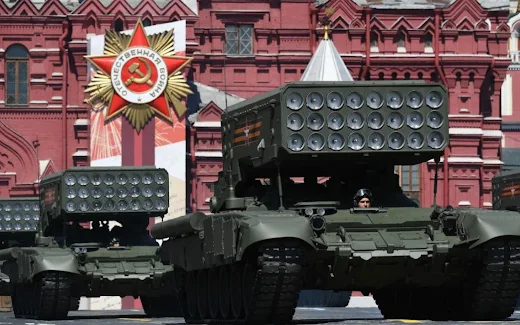 |
| TOS-1A Solntsepyok multiple thermobaric rocket launchers during the Victory Day military parade in Red Square marking the 75th anniversary of the victory in World War II |
International Military - The horrors of the Russian-Ukrainian war were illustrated by the ferocious TOS-1A Thermobaric bomb attacks near Novomykhailivka and Lyman, both in the Donetsk region of the Donbas. The damage caused by the Thermobaric artillery system attack looks so massive and gives goosebumps.
Quoted from The War Zone, the recording of the Thermobaric bomb attack was the first in a series of launches carried out in the Russia-Ukraine conflict. This video clip shows the horrific impact of the TOS-1A Solntsepek or Sunshine Thermobaric bomb attack.
Read Also: Russian BMP-3F Duplicate, Chinese-made ZBD-05 Amphibious Tank Less Interested in the Market
In the footage, it is clear that the large shock wave caused by the thermobaric spin is accompanied by several explosions at once during the attack. This phenomenon is called a condensation cloud or Wilson cloud which characterizes the Thermobaric bomb.
The resulting massive explosion took advantage of the high humidity conditions in the area surrounding the bombing, causing a decrease in the density of the surrounding air. Then, it cools the air temporarily and causes some of the moisture in it to condense.
This creates a bubbly Wilson cloud. The TOS-1A rocket uses a thermobaric warhead or fuel-air so it is often called a vacuum bomb. This bomb uses the oxygen in the surroundings to create a high-temperature explosion to destroy surrounding objects.
Upon hitting the target, the bomb payload opens the fuel container and scatters the Wilson cloud. Then a second charge ignites a cloud of fuel that produces a fiery explosion and oxygen-sucking vacuum.
Read Also: Destroy Ukrainian Armory, Russia's Mikoyan MiG-31K Fighter Jet Has Sophisticated And Deadly Specs
The explosion of the rocket causes changes in air pressure so fast and drastic that it causes terrible damage. Even shelter in a trench or cave, behind a reinforced barrier, or in some cases in armored vehicles, would not be able to protect humans.
The main effect of the TOS-1 bomb was a long-duration high-pressure blast wave that created a vacuum, then precipitated a counterwave. These pressure/vacuum spikes (up to 427 pounds per square inch) cause a tearing effect in soft materials (such as aircraft skin, radar surfaces, human lung tissue),” writes the US Army Training and Doctrine Command's (TRADOC) unclassified World Equipment Guide ( WEG) in the 2011 edition.
Walls and surfaces within the blast-affected area are not always able to provide protection, even causing multiple pressure waves, thereby amplifying the effects of damage and may collapse building structures,” continued TRADOC. The Thermobaric bomb system was fired from the TOS-1A multiple launch rocket system (MLRS), which was a variant of the TOS-1 at the end of the Cold War.
The TOS-1A entered Russian military service in 2001 with the complete system mounted on the chassis of the T-72 tank. First used by the Russian Army in Chechnya, as indirect fire support of infantry units and main battle tanks.
Read Also: Highly Flexible, India's Astra BVR Missiles Can Be Paired With Russian Fighters
The vehicle is equipped with a rotating launch system capable of carrying up to 24 thermobaric rockets and can be launched in six to 12 seconds. “The secondary effect is high temperature heat of about 2,500-3,000°C. An incomplete explosion produces an almost devastating effect, a high temperature flame with a wide long duration.
The impact of the Thermobaric bomb damage psychologically causes trauma and physically weakens the opponent." TRADOC Description. Russia uses this destructive weapon to destroy Ukrainian military forces that are sheltering in trenches or underground. It is reported that several Ukrainian military units use structures and trench lines in defense in the Donbas region. So the Thermobaric bomb played an important role in destroying such solid defenses.
